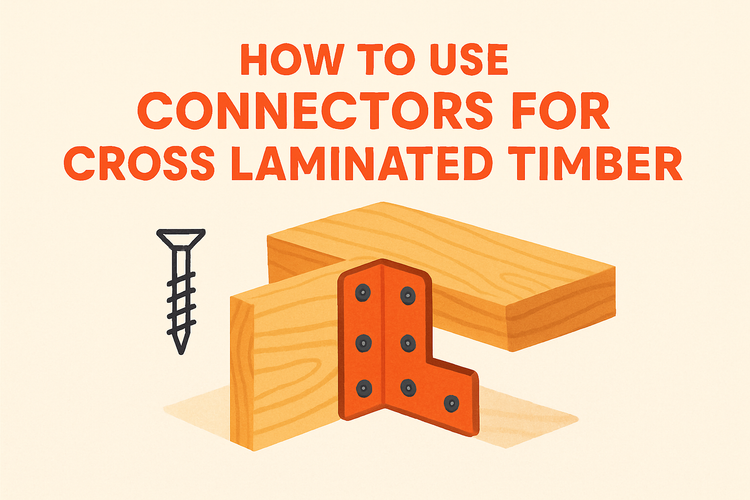How To Use Connectors For Cross Laminated Timber For Timber Projects

Benefits of Using Connectors for Cross Laminated Timber
Connectors for cross laminated timber (CLT) are essential for ensuring structural integrity and simplifying installation processes. These components offer safety, durability, and design flexibility in any mass timber construction project.
When incorporated correctly, CLT connectors provide enhanced load transfer between panels, as well as seamless attachment to other construction elements. Their use significantly reduces construction time and labor costs while increasing the overall efficiency of the build. Furthermore, they can support complex architectural designs that standard connection methods might limit, making them ideal for modern sustainable architecture.
The high strength-to-weight ratio of CLT panels is complemented by reliable connection systems that optimize performance in wind, seismic, and vertical load conditions. When matched with suitable Joist Hangers or custom brackets, these connectors contribute to safer, longer-lasting timber projects.
Types of CLT Connectors and Their Roles
Understanding the different types of connectors for cross laminated timber ensures proper application in your timber project. Each type serves a distinct purpose, from anchoring to transferring loads or tying structural components.
Angle brackets, nails, screws, and straps are often employed to secure panel edges or corners. Simple angle brackets might suffice in light-duty jobs, but more robust connectors are used in high-stress areas, like wall-to-floor or wall-to-wall intersections. These not only offer strength but also align with aesthetic goals of exposed timber surfaces.
Specialized connectors for cross laminated timber include concealed brackets, shear connectors, lifting devices, and hold-downs, all designed to accommodate the unique grain and strength properties of CLT. For vertical anchorage of post elements, Post Bases can be used in tandem with these connectors to stabilize structural loads efficiently.
Choosing the right type of connector also depends on fire rating requirements, spanning capabilities, and transportation considerations. Modular systems that incorporate tested connectors greatly reduce the margin for error on-site and support quicker assembly.
Installation Techniques for Optimum Performance
Proper installation of CLT connectors directly influences the performance and safety of any timber project. Following manufacturer guidelines and structural calculations ensures long-term reliability.
One of the key steps is precise positioning. Connectors must align perfectly with the load paths of the CLT panels. Even a slight misalignment can compromise the system’s ability to bear loads or resist movement. Mechanical fasteners like long screws or dowels may be predrilled into panels to avoid splitting the laminated layers.
Another critical point is to check wood moisture levels before installing connectors. Installing into overly moist CLT can lead to shrinkage issues later, reducing the reliability of the fixings. In wind-prone areas, High Wind Ties & Timber Connectors can supplement regular fastening systems to increase lateral resistance.
Sealing and insulation around connectors is equally crucial for buildings that meet energy-efficient standards. Many connectors are now designed to be concealed or flush with the panel, offering both fire protection and a clean visual finish.
Design Considerations and Load Calculations
Choosing the correct connector system depends on careful structural design and load assessment. Engineers must calculate both vertical and horizontal forces acting on each joint.
Load conditions vary depending on how the CLT element is used—whether as a floor, wall, or roof component. Shear forces and tension must be anticipated, particularly in multi-storey buildings or those exposed to high environmental loads. Selecting the right combination of fasteners and brackets according to the connection location ensures a balanced distribution of stress.
For wall-mounted applications, combining Restraint Straps with primary CLT connectors can manage out-of-plane forces during seismic conditions. Such integrations support both lateral bracing and overturn resistance, reducing risks in tall timber constructions.
Digital modeling tools help visualize stress points and simulate connector performance. Engineers and designers can experiment with joint layout before installation begins, making it easier to meet building code requirements while ensuring constructability and resilience.
Maintenance and Long-Term Durability of CLT Connections
To ensure the long-lasting performance of CLT connectors, some level of maintenance is required, especially in exposed or humid environments. Material compatibility is essential to avoid corrosion or degradation over time.
Galvanized or stainless steel connectors offer superior durability compared to untreated metal components. Periodic inspections can help identify early signs of wear or displacement, allowing for minor adjustments before failure occurs. In exterior applications, weather-proofing methods around connections further extend their lifespan.
Connectivity systems that are embedded within the timber may require less upkeep but still need to be checked during annual safety procedures. The use of protective coatings or insulation barriers helps reduce temperature-driven movement and moisture intrusion, maintaining joint stability and energy efficiency alike.
By selecting components from established sources such as dedicated Connectors for Cross Laminated Timber collections, builders gain peace of mind with tested durability and manufacturer support. Systematic maintenance ensures structural integrity for decades to come, supporting the sustainable promise of mass timber construction.
